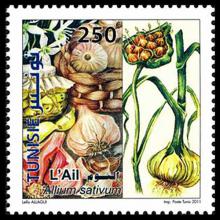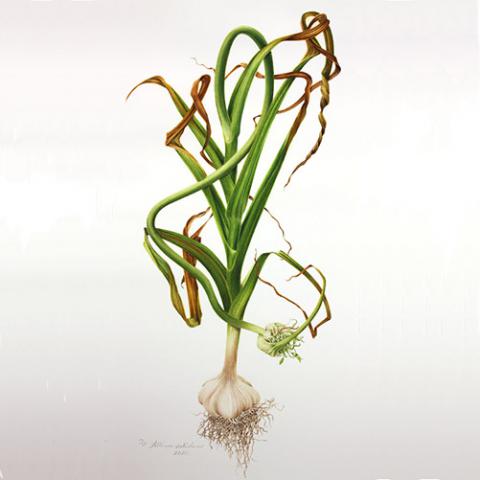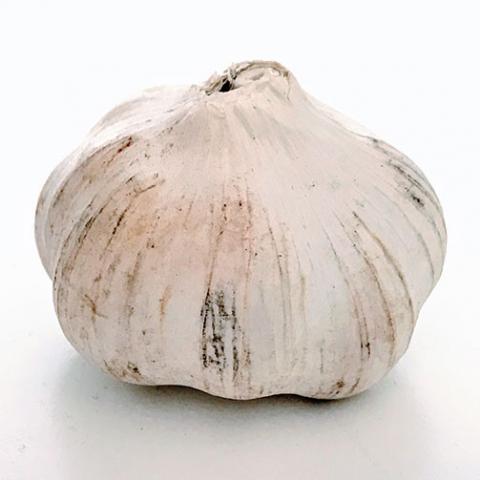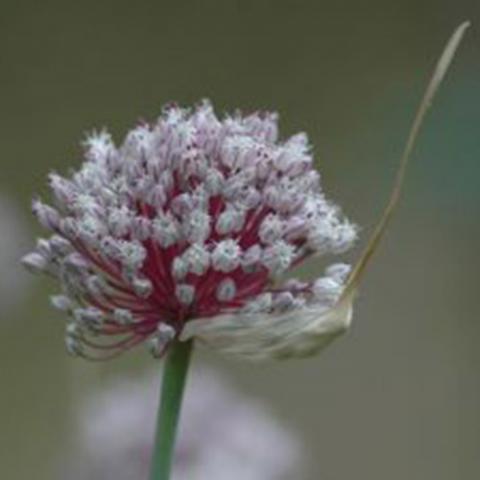NAME(S)
TAXONOMY
PLANTAE ID
THERAPEUTIC
Tunisia
Issued:
Stamp:
Allium sativum
Tunisia
Issued:
Stamp:
Allium sativum
Tunisia
Issued:
Stamp:
Allium sativum
Genus species (Plantae): Allium sativum
Garlic (Allium sativum) is a species in the onion genus, Allium. Its close relatives include the onion, shallot, leek, chive, Welsh onion and Chinese onion. It is native to Central Asia and northeastern Iran and has long been a common seasoning worldwide, with a history of several thousand years of human consumption and use. It was known to ancient Egyptians and has been used as both a food flavoring and a traditional medicine. China produces some 80% of the world's supply of garlic.
Etymology
The word garlic derives from Old English, garlēac, meaning gar (spear) and leek, as a 'spear-shaped leek'.
Description
Allium sativum is a perennial flowering plant growing from a bulb. It has a tall, erect flowering stem that grows up to 1 m (3 ft). The leaf blade is flat, linear, solid, and approximately 1.25–2.5 cm (0.5–1.0 in) wide, with an acute apex. The plant may produce pink to purple flowers from July to September in the Northern Hemisphere. The bulb is odoriferous and contains outer layers of thin sheathing leaves surrounding an inner sheath that encloses the clove. Often the bulb contains 10 to 20 cloves that are asymmetric in shape, except for those closest to the center. If garlic is planted at the proper time and depth, it can be grown as far north as Alaska. It produces hermaphrodite flowers. It is pollinated by bees, butterflies, moths, and other insects.
Properties
Fresh or crushed garlic yields the sulfur-containing compounds allicin, ajoene, diallyl polysulfides, vinyldithiins, and S-allylcysteine; as well as enzymes, saponins, flavonoids, and Maillard reaction products, which are not sulfur-containing compounds.
The phytochemicals responsible for the sharp flavor of garlic are produced when the plant's cells are damaged. When a cell is broken by chopping, chewing, or crushing, enzymes stored in cell vacuoles trigger the breakdown of several sulfur-containing compounds stored in the cell fluids (cytosol). The resultant compounds are responsible for the sharp or hot taste and strong smell of garlic. Some of the compounds are unstable and continue to react over time.
Among the members of the onion family, garlic has by far the highest concentrations of initial reaction products, making garlic much more potent than onion, shallot, or leeks. Although many humans enjoy the taste of garlic, these compounds are believed to have evolved as a defensive mechanism, deterring animals such as birds, insects, and worms from eating the plant. Because of this, people throughout history have used garlic to keep away pests such as mosquitoes and slugs.
A large number of sulfur compounds contribute to the smell and taste of garlic. Allicin has been found to be the compound most responsible for the "hot" sensation of raw garlic. This chemical opens thermo-transient receptor potential channels that are responsible for the burning sense of heat in foods. The process of cooking garlic removes allicin, thus mellowing its spiciness. Allicin, along with its decomposition products diallyl disulfide and diallyl trisulfide, are major contributors to the characteristic odor of garlic, with other allicin-derived compounds, such as vinyldithiins and ajoene.
Because of its strong odor, garlic is sometimes called the "stinking rose". When eaten in quantity, garlic may be strongly evident in the diner's sweat and garlic breath the following day. This is because garlic's strong-smelling sulfur compounds are metabolized, forming allyl methyl sulfide. Allyl methyl sulfide (AMS) cannot be digested and is passed into the blood. It is carried to the lungs and the skin, where it is excreted. Since digestion takes several hours, and release of AMS several hours more, the effect of eating garlic may be present for a long time.
The well-known phenomenon of "garlic breath" is allegedly alleviated by eating fresh parsley. The herb is, therefore, included in many garlic recipes, such as pistou, persillade, and the garlic butter spread used in garlic bread.
Because of the AMS in the bloodstream, it is believed by some to act as a mosquito repellent, but no clinically reported evidence suggests it is actually effective.
Abundant sulfur compounds in garlic are also responsible for turning garlic green or blue during pickling and cooking. Under these conditions (i.e., acidity, heat) the sulfur-containing compound alliin reacts with common amino acids to make pyrroles, clusters of carbon-nitrogen rings. These rings can be linked together into polypyrrole molecules. Ring structures absorb particular wavelengths of light and thus appear colored. The two-pyrrole molecule looks red, the three-pyrrole molecule looks blue, and the four-pyrrole molecule looks green (like chlorophyll, a tetrapyrrole). Like chlorophyll, the pyrrole pigments are safe to eat.
Upon cutting, similar to a color change in onion caused by reactions of amino acids with sulfur compounds, garlic can turn green.
Reference: Wikipedia
Illustration: Milly Acharya




